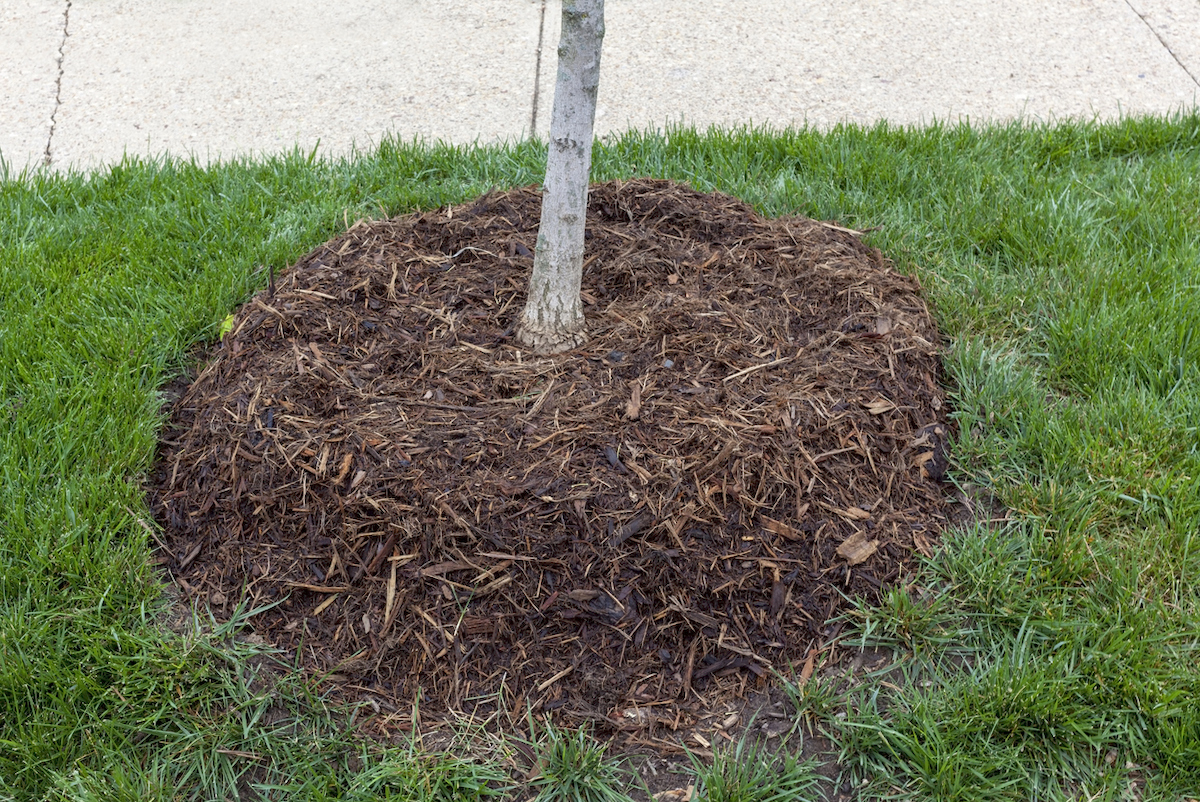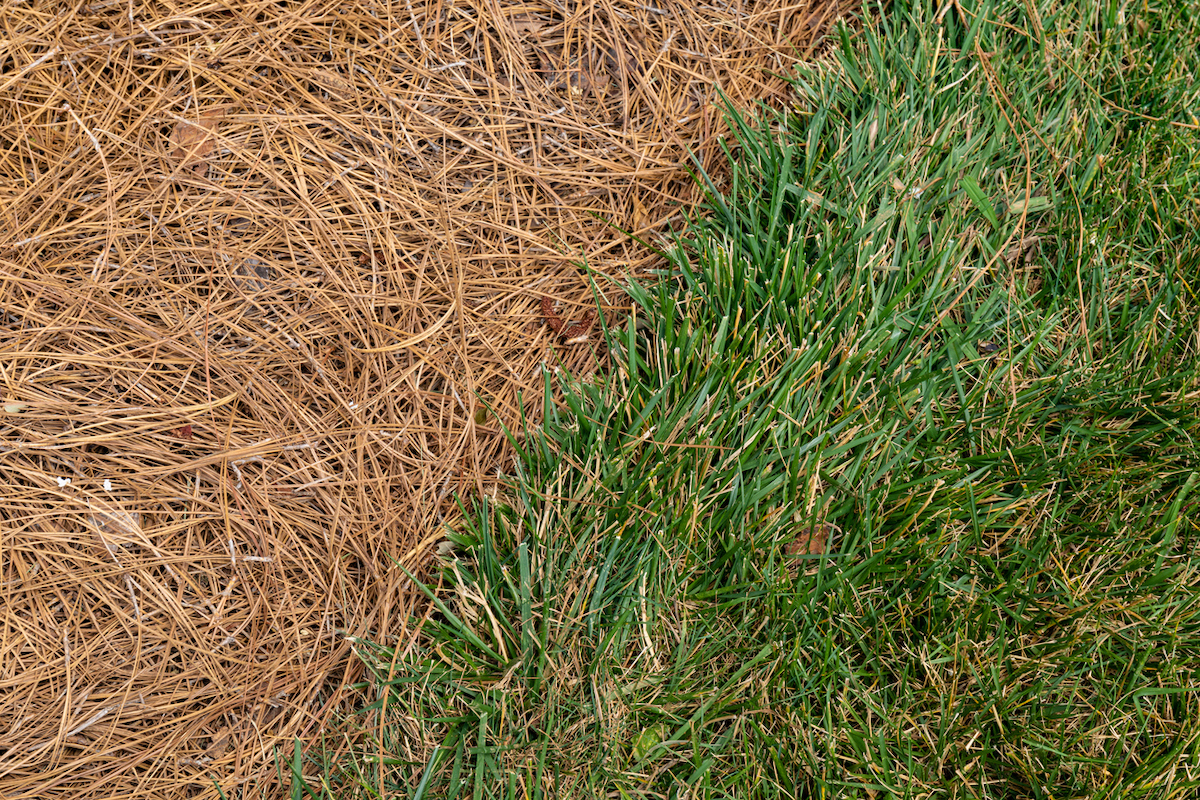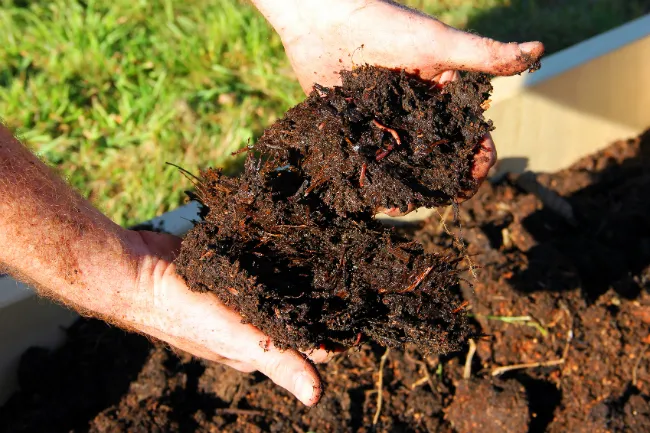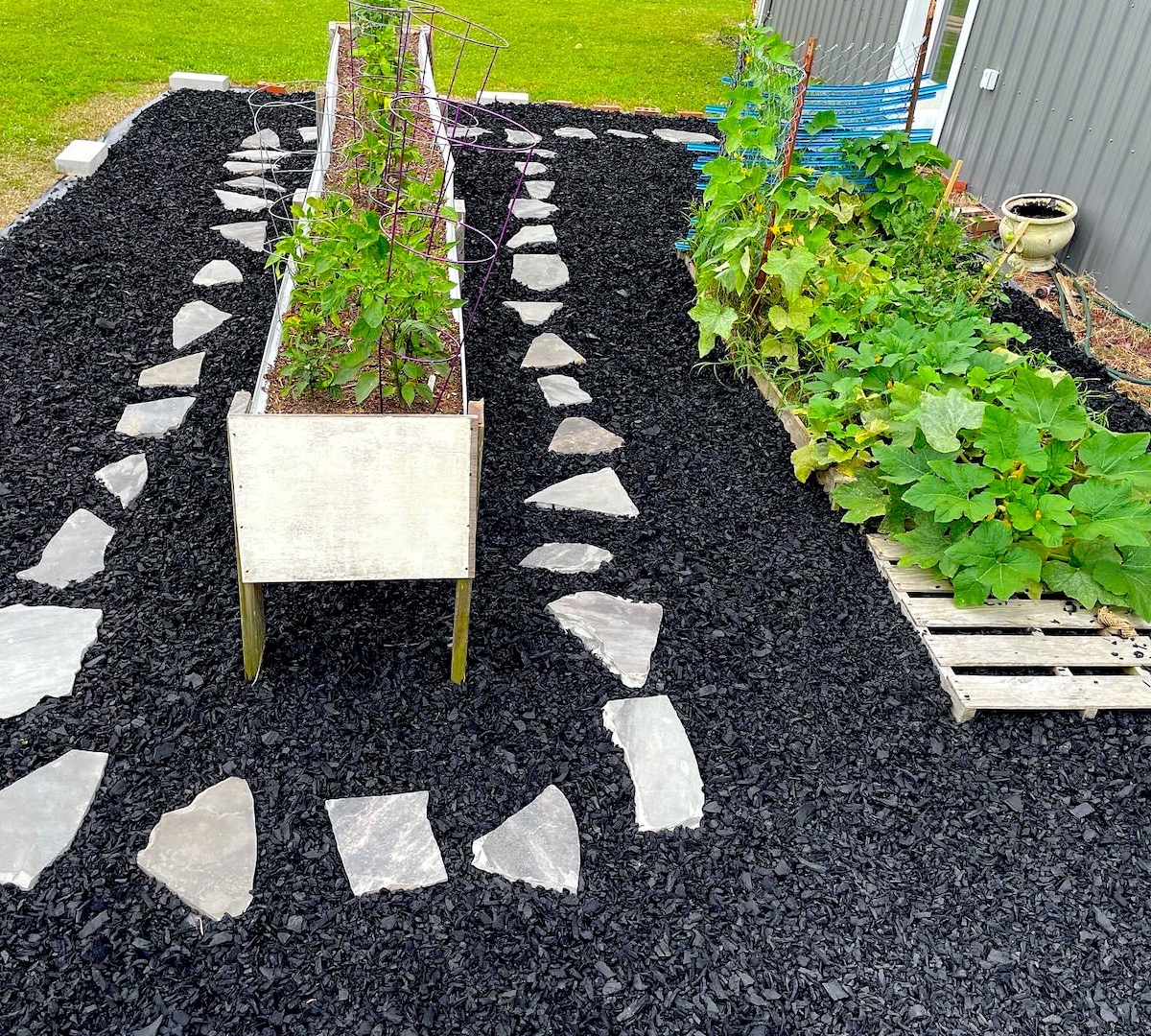We may earn revenue from the products available on this page and participate in affiliate programs. Learn More ›
Mulch can help your garden thrive, and keeps it looking more tidy. Virtually all types of mulch for landscaping can give planting beds an attractive, manicured, and well-maintained appearance. This gardening must-have also helps minimize weed growth and prevent soil compaction, and insulates sensitive plants from cold, heat, or drought.
“Mulches can provide an easy way for a homeowner to maintain higher levels of moisture in beds, and to a lesser extent inhibit weed growth,” explains Alan Burke, ASLA, landscape architect at The Outdoor Project Company. “Mulch provides a uniform surface that can visually integrate beds in the landscape. Mulches can also help maintain comfortable soil temperatures during extreme weather and can provide moderate amounts of nutrients,” says Burke.
Mulch comes in a wide variety of materials beyond the typical wood chip. But many mulch types share one basic purpose: improving soil conditions. Keep reading to discover the many organic and inorganic mulch options available and how they can benefit your garden.
What is mulch?

Mulch refers to a layer of material spread over the soil’s surface in gardens to act as a covering. It serves multiple purposes: acting as a protective barrier against erosion, conserving soil moisture by reducing evaporation, suppressing weed growth by blocking sunlight to weed seeds, moderating soil temperature fluctuations, and improving the look of garden beds.
What is mulch made of? “Mulch comes in different forms, from mineral mulches including gravel and sand mixes, to organic mulches made from compost or shredded leaves or arbor chips,” says Burke. “Synthetic mulches might include rubber or shredded tire material, and they are generally adverse to the environment.” On the other hand, organic mulch enriches the soil as it decomposes by adding nutrients and improving soil structure, fostering healthier plant growth and overall ecosystem vitality.
Benefits of Mulching
- Suppresses weed growth by blocking sunlight and preventing weeds from germinating
- Improves moisture retention by reducing evaporation from the soil surface
- Controls soil temperature by serving as insulation and keeping the soil cooler in hot weather and warmer in cold weather
- Prevents soil compaction by protecting it from being walked on by people and pets
- Minimizes erosion by forming a protective layer over the soil from wind and water
- Enriches soil as the organic material decomposes over time
- Enhances aesthetics by adding a tidy or colorful appearance to landscaped areas
- Can create a habitat for beneficial organisms, such as earthworms, which help improve soil health and fertility
- Helps prevent spread of soil-borne diseases
How to Spread Mulch
Before applying mulch, determine how much mulch you need. Start by clearing the area of any weeds, rocks, or debris. Ensure that the soil is evenly moist before spreading the mulch. Spread a layer of mulch evenly over the soil surface, making sure to leave a small gap around the base of plants to prevent moisture-related issues. The depth of mulch can vary depending on the material used and the purpose of mulching. Generally, a layer of 2 to 4 inches of garden mulch is sufficient for most beds. However, coarser materials like wood chips or bark may require a deeper layer, while finer materials like compost or shredded leaves may need a thinner layer.
Do not pile mulch against plant stems or tree trunks, as this can lead to problems with insect or rodent infestation. Also, avoid over-mulching since mulch that is too deep can cause a buildup of excess moisture in the root zone, which can stress the plant and lead to root rot. Once applied, periodically check the mulch depth and replenish it as needed to maintain the desired thickness and reap the full benefits of mulching throughout the growing season.
When to Apply Mulch

The ideal time to apply mulch is typically in the spring, after the soil has warmed up and dried out enough to work with, but before the heat of summer sets in. This timing allows for optimal weed suppression and moisture retention during the growing season. However, mulch can also be applied in the fall to help insulate the soil and protect plant roots from freezing temperatures during the winter months.
As far as how often to replace mulch, organic varieties like wood will eventually degrade. It will most likely need to be replaced or topped off annually. On the other hand, inorganic mulches like gravel can last years—even over a decade.
Organic vs. Inorganic Mulches
Organic mulches are made from materials that decompose over time. Examples include hardwood and softwood chips, bark, evergreen needles, leaves, grass clippings, compost mixes, newspaper, cardboard, and a variety of other plant byproducts. They work best for homeowners who want to give their lawn a nutrient boost.
Because organic mulches decompose, they must be replenished regularly, which can be a drawback. However, they tend to be less expensive than inorganic varieties.
Inorganic mulches do not decompose, but can be better for controlling weeds, enhancing a yard’s appearance, and saving time, since they do not need to be replenished often, if ever. Options include rock, stone, lava rock, crusher dust, pulverized rubber, landscape fabrics, and other human-made materials. Because rocks and stones absorb and reflect heat, they have the advantage of warming the soil for early spring planting of fruits and vegetables, but can be detrimental to plants during periods of hot, dry weather.
Types of Mulch
When you’ve decided you’re ready to start enjoying the numerous benefits of mulch, you’re not limited to just the standard by-the-bag chips from home improvement centers—you have options! Select from the many different types of mulch based on local availability, cost, appearance, quality, benefits to soil, and durability. Evaluate the organic and inorganic options below that work best for your landscape.
Organic Mulches
Organic mulches are natural materials that break down in the soil. In the short term, they offer benefits of mulch for beds, and over time, they can improve soil fertility, aeration, structure, and drainage.
Wood Chips, Nuggets, or Bark

Both hardwood and softwood bark, chips, and nuggets—byproducts of the lumber and paper industries—are typically aged and dried, and sometimes even dyed red or black, then sold in bags. Shredded hardwood mulch works best around trees, shrubs, and in perennial beds and decomposes more slowly than softwoods. Typically made from pine or cedar, these mulches should be reserved for use around large trees and shrubs. Pine tends to be slightly more acidic and therefore takes longer to decompose than other organic mulches.
Check with your local municipality before you shop for mulch; many offer freshly ground tree mulch to homeowners at no charge. This fresh material is neither dried nor aged, so use it only for walkways, as it leaches large amounts of nitrogen from the soil as it decomposes.
Best for: Gardens or pathways, around trees or shrubs, and in flower beds
Straw

Clean wheat, barley, or oat straw is the best mulch for lightly covering newly seeded lawns. The straw mulch keeps the grass seed from washing away, deters feeding birds and rodents, and, until it decomposes, conserves the moisture the seeds need for good germination. When you’re shopping for mulch, don’t confuse straw with hay. You should avoid the latter, which contains seeds that could sprout up as weeds in your garden.
Best for: Newly seeded lawns, and germinating vegetables and flowers.
Pine Needles

Also known as pine straw, pine needles are effective as mulch, especially for flower beds. They come in non-colored, natural light brown, and sometimes can be found in red and brown shades. Pine needles are great for flowers and vegetables that need protection during the winter months since they help insulate the ground and stabilize the temperature of the soil. Pine needles also help prevent weeds, erosion, and evaporation.
Best for: Around trees and shrubs, and in flower or vegetable gardens.
Grass Clippings or Shredded Leaves

No need to shop around—you can make your own organic mulch using nothing more than grass clippings or shredded leaves. Leaf mulch is ideal for use in garden beds and around trees and shrubs, while grass clippings may be spread in thin layers across vegetable and perennial beds and then turned into the soil at the end of the growing season. Be careful not to apply in thick layers, or the material will mat. Also, don’t save the clippings from lawns that have been treated with herbicides or insecticides.
Best for: Flower beds, vegetable gardens, and around trees and shrubs.
Leaf Mold

Another option is to compost fallen, shredded leaves to form leaf mold mulch for the garden. It boosts nutrients in the soil and helps with water retention. It’s best to let it sit for at least 6 months before applying; it doesn’t need to look like soil to be ready. Some people let the shredded leaves sit for 1 to 2 years, but the timing will really depend on the size of the leaves, geographic location, and climate.
Best for: Garden beds and vegetable gardens
Newspaper

Shredded black-and-white newspaper can be used as an effective weed suppressant. Apply two to three layers at a time, then cover with another heavier organic material, such as leaves or grass clippings, to hold the lightweight mulch in place. Take care not to mix in color newspaper pages since they do not decompose readily and may even expose your garden to toxic dyes.
Best for: Flower beds and vegetable gardens.
Cardboard

Cardboard is another great mulch option to deter weeds, since it blocks the sun; this makes it a good mulch for preparing garden beds. It also serves as a way to feed plants as the material decomposes. Be sure to choose undyed natural cardboard and to remove any stickers or tape to avoid adding toxic chemicals to the yard. Avoid a thick, solid layer of the material over an active bed, since it can inhibit air and some moisture from reaching the soil below. Overall, cardboard is an eco-friendly and free way to recycle the boxes lying around your house while helping your garden flourish.
Best for: Prepping flower beds and vegetable gardens.
Cocoa Chips

Popular for their rich color and pleasant scent, cocoa bean hulls are lightweight, easy to handle, and appropriate for all planting areas. Don’t apply more than 1 inch or water excessively, because cocoa chips already decompose quickly. And since they’re a pricier option, you won’t want to have to do more than an annual application. If you have pets or wildlife, avoid cocoa mulch since chocolate and its byproducts can be fatal to animals if consumed.
Best for: Flower beds, vegetable gardens, or around trees and shrubs

Why Dog Owners Should Not Use Cocoa Mulch
Your pet’s “possible ingestion of cocoa bean hulls,” warns Karen Hirsch, DVM, a lecturer at Cornell University’s Department of Veterinary Medicine, should give dog owners pause about using cocoa mulch.
“Like the cocoa beans they harbor and the chocolate made from those beans, cocoa shells contain theobromine, a methylxanthine compound related to caffeine that dogs are very sensitive to.” Because the cocoa bean hulls smell like chocolate, they may induce a dog who would not otherwise eat mulch to start munching. If ingested in sufficient quantities, the hulls could lead to chocolate intoxication, which can result in death.
Hazelnut Shells

Hazelnut shells are an attractive yet expensive mulch option. The cracked hulls of the shells last several years and are amber in color. Some of the key benefits of using hazelnut shells for mulch include: it breaks down more slowly than other organic mulches so it doesn’t need to be replaced often, is lightweight, reduces weeds, deters pets and slugs, and helps with soil retention.
Best for: Perennials and vegetables in raised gardens, flower beds, as a ground cover, or pathway surface
Compost

Composting kitchen scraps and garden trimmings is another way to create desirable mulch. After decomposing over time in the dark, these materials transform into nutrient-rich dirt that works well in the garden. Often referred to as “black gold,” compost mulch saves money (it’s free to make) and is environmentally friendly. It helps retain soil moisture and provides plants with key nutrients like nitrogen and carbon.
The downside to compost is that it doesn’t last forever and breaks down quickly, so it needs to be refreshed every month or so. While materials like coffee grounds, eggshells, fruits and vegetables, leaves, and grass clippings work well for compost, avoid meat trimmings, fatty foods, oils, pet waste, charcoal or coal ash, bones, and anything treated with chemicals.
Best for: Improving soil in flower beds and vegetable gardens
Composted Animal Manure

Nothing beats well-composted, nutrient-rich animal manure when it comes to mulch for vegetables. These manures are typically from herbivores (plant-eating animals), such as cows, sheep, and chickens. Manure supplies primary nutrients (nitrogen, phosphorus and potassium) and micronutrients for plant growth. In addition, it boosts soil organic matter, which helps improve drainage in clay soils, increases the water-holding capacity of sandy soils, provides a source of slow-release nutrients, and promotes growth of beneficial soil organisms.
While animal manure can be effective, there are some warnings to consider before adding it to your garden. Fresh manure can burn plant roots. This is because fresh manure contains high amounts of ammonium or soluble nitrogen. Poultry manure is especially high in ammonia and burns if used too much. Prevent a problem by incorporating the manure 6 to 8 inches within 12 hours after application. Do not add manure to vegetable gardens within 4 months of the expected harvest date to avoid adding disease pathogens to soil or use only composted manure. Additionally, avoid dog, cat, and pig manure because they can harbor disease-causing organisms.
Best for: Vegetable gardens
Inorganic Mulch
Inorganic mulches don’t improve the soil underneath, but they can be very effective at weed prevention and adding color or texture to a landscape design. They last longer than most organic mulches.
Rock or Crusher Fine

Lava rock, gravel or crusher fine (dust), marble chips, and pea gravel will not break down into the soil below, making them a popular option for walks and pathways, thanks to their one-time investment of cost and labor. Avoid using stones around most trees, shrubs, and other plants, unless suggested by a landscaping expert. Stones won’t retain moisture effectively and can cause heat stress on all but the most heat-tolerant plants through reflection as well as ground heating, which can burn roots.
Best for: Hardscapes and pathways, or sprinkled on lawns and gardens
Landscape Fabric or Plastic

Although not actually a type of mulch, landscape fabric and landscape plastic can be laid over soil to prevent weed growth in a flower bed. Plastic polyethylene film is impermeable, which means that water and other nutrients cannot pass through. While this quality makes it ideal as a short-term weed killer, plastic is not suitable for long-term use.
If you use plastic to warm the soil around fruit and vegetable plants, you’ll have to install an irrigation system under the plastic or water plants by hand to make sure they get adequate moisture and air. Remove the plastic at the end of the growing season to keep it from deteriorating in the sunlight, and then replace it the following year.
Landscape fabric is a better choice for long-term use, as it suppresses weeds but allows air and water to pass through; however, it is an expensive material. Landscape fabric is best used with a layer of mulch, such as wood chips or gravel, on top.
Best for: Flower beds and gardens that require minimal digging, and around trees and shrubs
Rubber

Rubber mulch is manufactured from recycled, pulverized tires. It is inexpensive, durable, and somewhat soft, which makes it perfect for high-traffic areas such as playgrounds. Think twice before using it in home landscaping projects, though, because it has disadvantages that might give you pause: As it bakes in the sun, it starts to give off a pungent smell; certain bacteria feed readily on rubber material; it decomposes slowly; it is less effective in controlling weeds than organic mulches; and it can cause leaf yellowing, reduced tree growth, and increased tree mortality.
The jury’s still out whether toxins found in the rubber can leach into the soil. Concerns have been raised about the health risks of recycled tire crumbs used in playing fields, so the U.S. Environmental Protection Agency (EPA), the Centers for Disease Control and Prevention/Agency for Toxic Substances and Disease Registry (ATSDR), and the U.S. Consumer Product Safety Commission (CPSC) are currently studying key environmental human health questions regarding this material.
Best for: Hardscaping, children’s play areas, and around trees and shrubs
Seashells

For a beachy feel, try mulching with seashells. They are beautiful as pathways and around plantings. They also provide benefits to the soil given the nutrients they contain. Shells from crustaceans like crab, lobster, and shrimp, for example, consist of chitin, which adds organic matter and slowly releases nitrogen, calcium, and magnesium into the soil.
Best for: Garden paths and in shaded areas
Recycled Tumbled Glass

Wow your neighbors by using recycled tumbled glass—made from used glass bottles, old windows, and other glass products—in your garden. Much like gravel or pebbles, this unique type of mulch comes in many gorgeous colors that never fade and are extremely durable. They add visual interest to the landscape design and don’t hold too much moisture around plants that favor dry soil. It’s recommended to layer landscape fabric under the mulch to keep the glass from migrating down through the soil.
Best for: Garden beds or rock gardens filled with plants that tolerate rocky, sandy soil.
When to Call a Professional
Mulching is one of the most straightforward DIY projects a homeowner can take on. “Depending on your physical ability, it is relatively easy to install mulch,” surmises Burke. “You can spread a tarp on the driveway and have a moderate amount dumped by a service. The material itself is not as heavy as soil or gravel, and can be moved relatively easily.” However, he recommends that if homeowners are installing mulch in excess of 10 cubic yards, using gravel, or working in beds that are located in hard-to-reach places, they should hire a professional.
The most challenging aspect of adding mulch is knowing how much to purchase, which can affect a landscaping budget. If unsure, it may be best to consult with a landscaper. Most bulk mulches are sold by the cubic yard. The typical cost of mulch per yard is between $30 and $150, with a national average of $75. A bag of pine chips, for example, typically costs $4 and covers about 8 square feet, whereas a cubic yard of pine chips covers approximately 108 square feet at a depth of 3 inches and costs $30.


